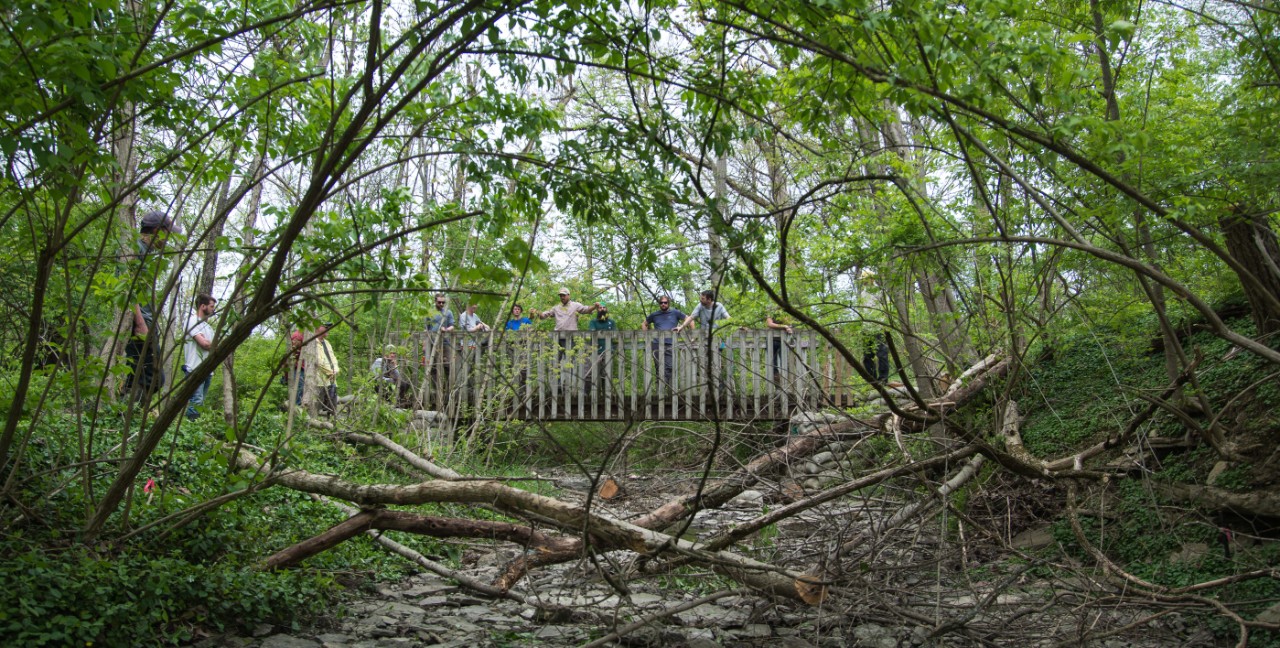
UC leads demonstration project to improve Ohio streams
Biologists launch pilot project that could have implications for health of waterways
Biologists at the University of Cincinnati are studying low-cost ways to improve water quality and wildlife habitat in Greater Cincinnati’s creeks.
Like many urban creeks, Cincinnati’s streams are routinely affected by routine flash floods, sewage overflows, pollution and stormwater runoff.
UC biologists Stephen Matter and Michael Booth are examining whether water quality and wildlife habitat can be improved simply by adding a touch more of Mother Nature. With a team of volunteers, they placed fallen logs and branches in select parts of the upper Cooper Creek, a stream in the Cincinnati suburb of Blue Ash that drains downstream into the larger Mill Creek and Ohio River.
The addition of fallen timber could help slow periodic floodwaters, create more standing pools for fish during droughts and reduce nutrients that could make their way downstream, researchers said.
“Cooper Creek typifies a lot of issues streams in Hamilton County face,” said Booth, an assistant professor who studies fish and aquatic ecology across the country.
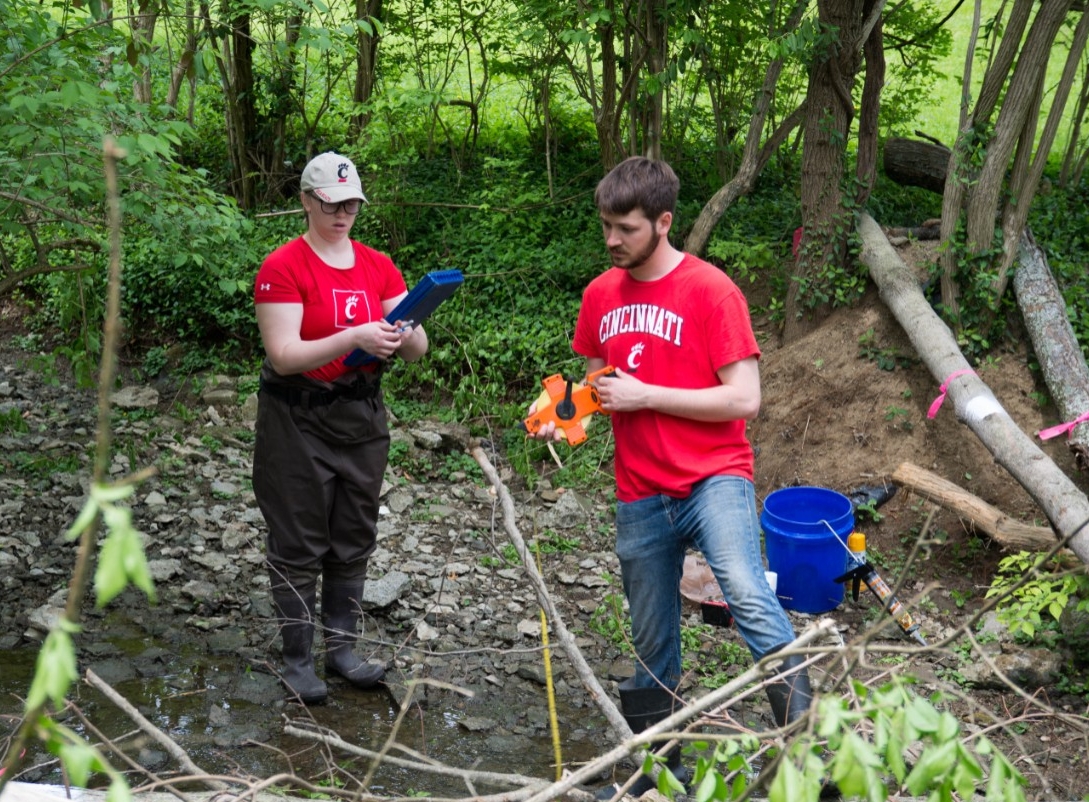
UC biology student Jayla Brown, left, and graduate student Peter Grap install transponders in timber to study how well it remains in place during periodic storms in the Cooper Creek. Photo/Michael Booth
“We know wood plays an important role for creating wildlife habitat. Cooper Creek is a boring place — lots of rocks but not much else,” he said. “In creeks you’d like to see a variety of habitats, fallen logs, standing pools and flowing water.”
The UC researchers presented the project in April to the Geological Society of America’s sectional conference in Cincinnati. The project is funded through the Ohio Water Resources Center through a grant from the U.S. Geological Survey.
Greater Cincinnati has an extensive network of creeks feeding its major rivers.
“These streams really are the lifeblood of the natural system,” said Matter, an associate professor of biology in UC’s College of Arts and Sciences.
“Most of our creeks are these small headwater streams. If you walk through Cincinnati, you’re going to run into one of these in every neighborhood,” Matter said. “Often they’re places we’d like to see nature.”
We’re looking for a cost-effective solution to deploy to improve urban streams.
Michael Booth, UC assistant professor of biology
But some Cincinnati creeks see raw sewage overflow during storms, which makes them a potential health risk, Matter said.
In Cincinnati, most creeks help divert standing water off roads, so they can turn from a trickle to a torrent after heavy rains. Fish and other aquatic life can be swept far downstream.
“There are lots of impervious surfaces. When it rains, you see a massive increase in stream flow. This leads to major changes in sediment and habitat available for aquatic life,” Booth said.
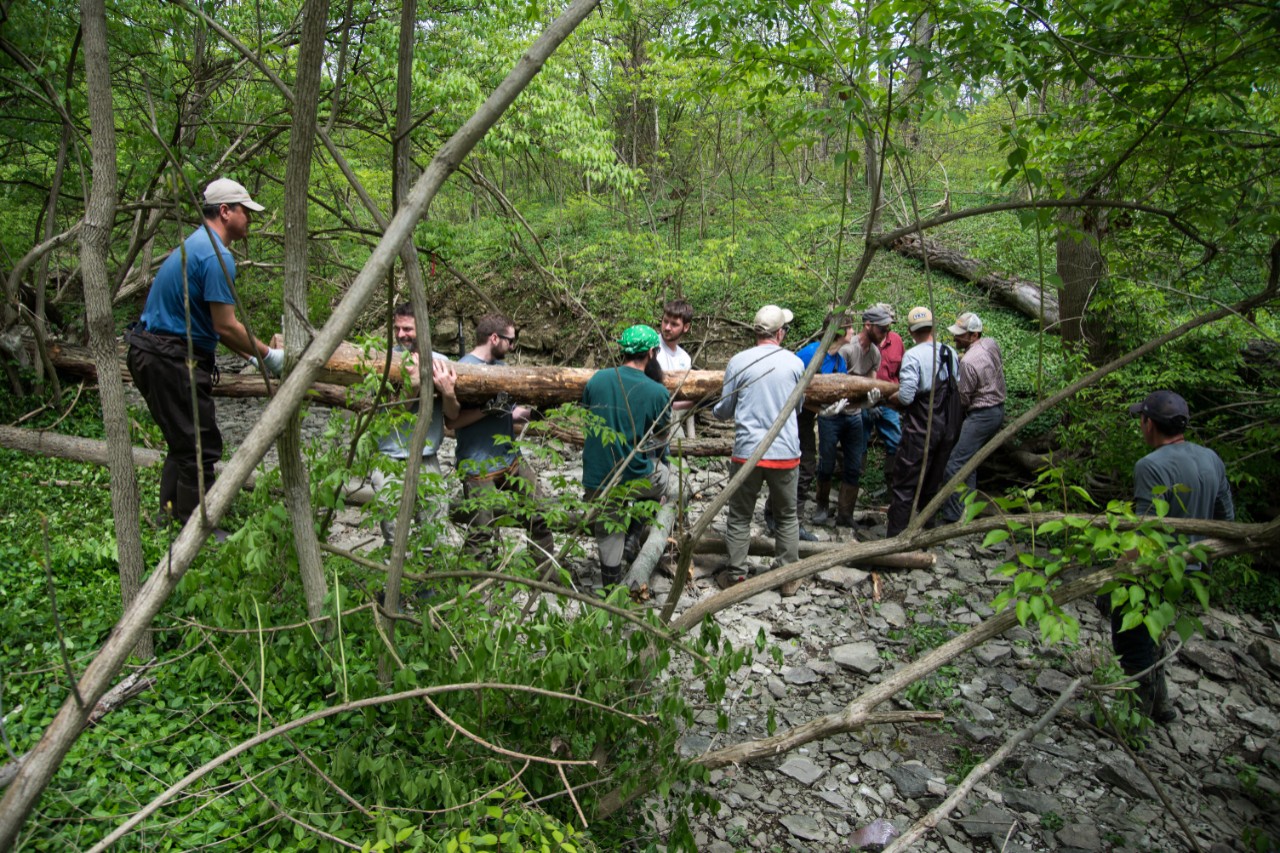
Staff from Cincinnati parks, the Environmental Protection Agency and the Hamilton County Conservation District help move heavy timber to Cooper Creek to help slow the flow of water during heavy storms and create standing pools for fish and other aquatic life. Photo/Michael Booth
As a result, while Ohio is home to 170 native freshwater fish, the upper section of Cooper Creek is home to just three species of fish today, Booth said.
“As we go downstream, we might add four or five more species,” he said.
That’s a startling lack of biodiversity and a sign of an unhealthy ecosystem, he said.
“But we would definitely expect to see double the number of fish species if we had better habitat and better connectivity for fish to move back up into these sections,” Booth said. “We’re looking for a cost-effective solution to deploy to improve urban streams.”
Adam Lehmann, stream conservation program manager for the Hamilton County Conservation District, is overseeing the demonstration project. He said the biggest challenge facing headwater streams in Ohio is they become bone dry between rainstorms.
“If a stream goes dry between rain events, the fish aren’t going to care how polluted the water is,” Lehmann said.
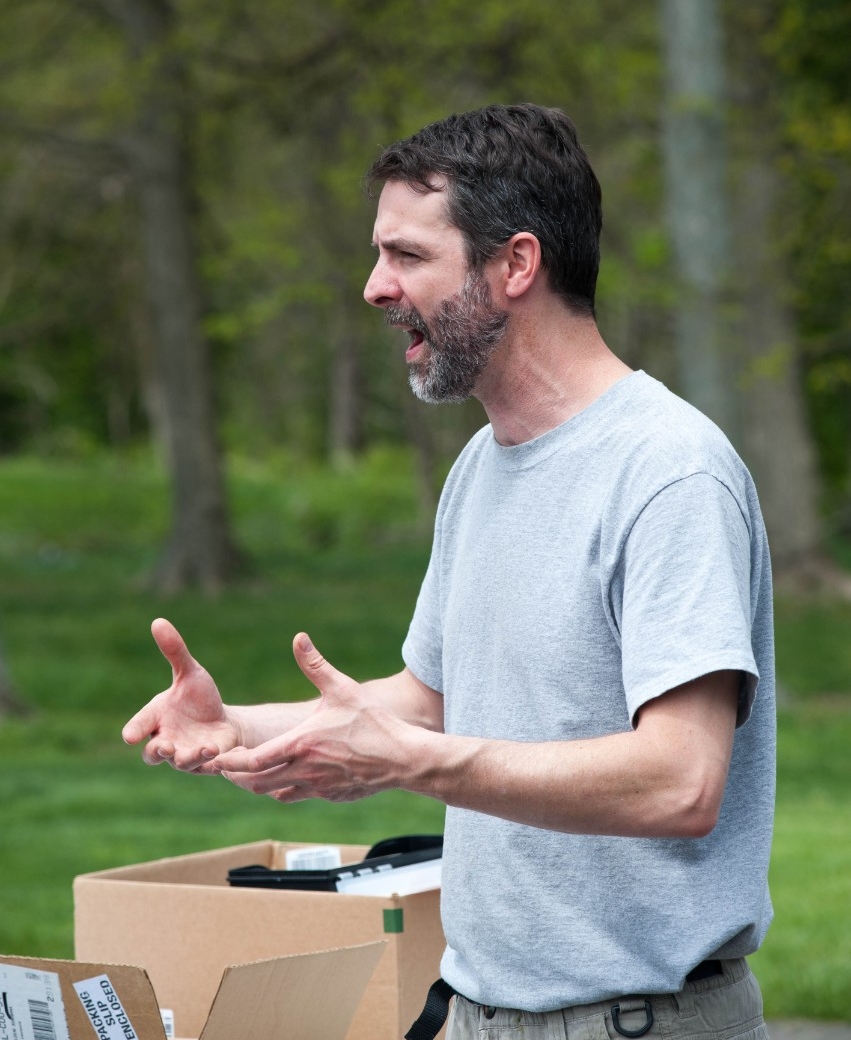
Adam Lehmann, stream conservation program manager for the Hamilton County Conservation District, oversees the pilot project. Photo/Michael Booth
But by placing heavy logs in strategic places in the creek where flooding won’t easily be able to wash them downstream, Lehmann said he hopes to use the rush of water to his advantage to create intermittent pools of water where fish and other aquatic life can survive between storms.
“Everybody understands that when a stream goes dry, fish are out of luck,” he said. “If we jam one side of a log against a tree, we can force the flow of water under the log to scour out a depression that will hold water in dry times.”
Lehmann said the logs should help to catch other flood-swept debris as well. Historically, fallen timber was removed from creeks to prevent it from clogging drainage culverts. Paradoxically, Lehmann said they expect to see less woody debris blocking drainage culverts by adding more heavy wood to the creek.
Restoring the natural hydrology of creeks can be expensive and labor-intensive, often requiring intrusive heavy equipment. Researchers are hoping to see similar benefits from less drastic efforts than bringing in backhoes.
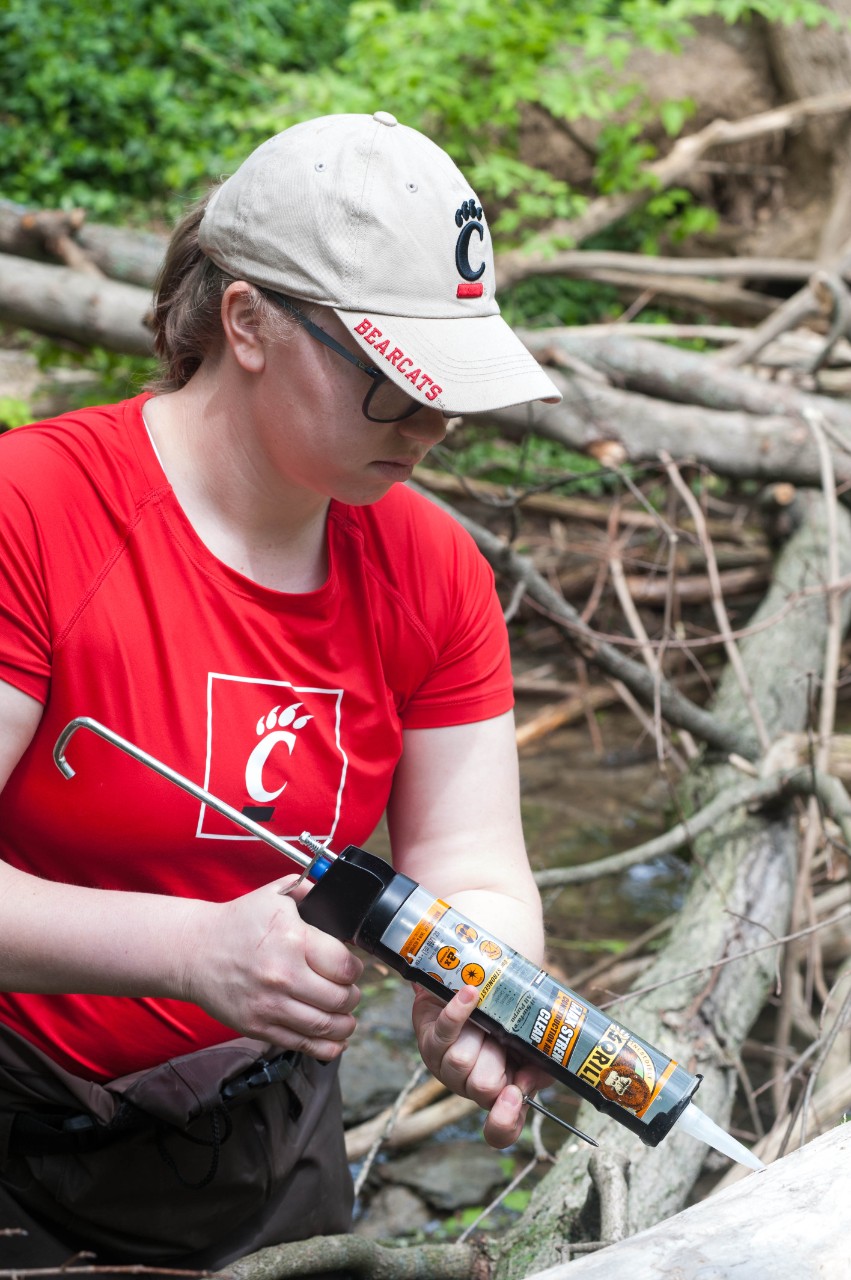
UC biology student Jayla Brown installs a transponder to a log to help researchers determine how well the timber remains in place during floods. Photo/Michael Booth
“I like to focus on scalable solutions,” Lehmann said. “You don’t have to mow down the forest to get in there. You don’t need to hire engineers or obtain Clean Water Act permits. And the wood is available free of charge.”
To gauge the project’s effectiveness, researchers plan to add little passive transponders to each log and return to see if the wood gets washed downstream or remains in place as they hope it will.
If the project is successful, it could demonstrate that relatively simple efforts can have profound benefits. Hamilton County is home to more than 1,000 headwater streams that feed its lakes and rivers, said Amanda Nurre, watershed specialist with the Great Parks of Hamilton County.
“We have a very impressive watershed in Hamilton County. There are small streams in every park. We’re very interested in finding low-cost ways to improve our streams. I think it could be a useful tool,” she said. “I’m optimistic to see if it can work.”
Featured image at top: UC biologists led a demonstration project at Cooper Creek to determine if simple methods such as adding timber to a creek can help improve the ecology of Ohio's streams. Photo/Michael Booth
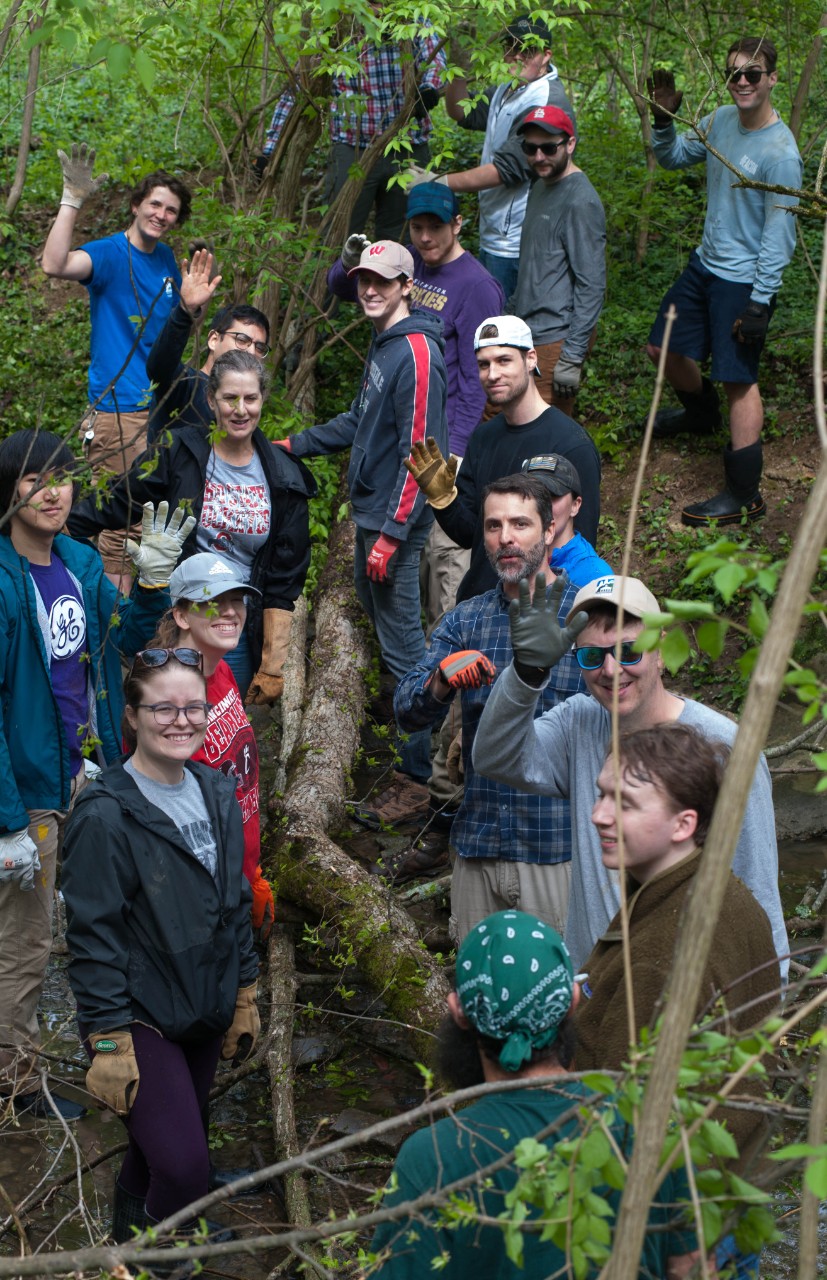
Volunteers from GE Young Professionals, led by agency trainees, help UC biologists with a demonstration project to improve stream ecology in Cooper Creek. Photo/Michael Booth
Impact Lives Here
The University of Cincinnati is leading public urban universities into a new era of innovation and impact. Our faculty, staff and students are saving lives, changing outcomes and bending the future in our city's direction. Next Lives Here.
Related Stories
OTR mural celebrates UC alumni success
April 4, 2025
The UC Alumni Association, UCAA, will mark its annual Alumni Celebration during its upcoming Alumni Week, April 7-13, with a community art project commemorating this year’s slate of alumni honorees receiving the organization’s top awards.
Study: Platform-predicted treatments improve outcomes for...
April 4, 2025
Results from a new Phase 3 trial published in the journal npj Precision Oncology found that an assay that includes an assessment of cancer stem cell sensitivity to chemotherapy can accurately decide more effective treatments and lead to increased outcomes for patients with platinum-resistant ovarian cancer.
Pediatrician celebrates 30th UC College of Medicine reunion with...
April 3, 2025
There’s a vital thread woven into the fabric of Chris Peltier’s life. It’s black and red, and it knits all things Bearcat together into a life that was transformed by the University of Cincinnati and the UC College of Medicine.
